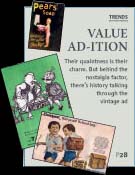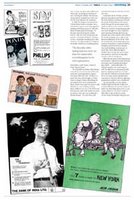 [My daytime job requires me to write. But I refrain from reproducing it here, on the blog. Primarily because they are two different entities. The me on the blog is quite different from the me in the publications I work for. But the following is different. One, I don't work for this publication. Two, I didn't write this for the greens. Three, this is because of what I do on this blog and it was just an extension on printed paper.
[My daytime job requires me to write. But I refrain from reproducing it here, on the blog. Primarily because they are two different entities. The me on the blog is quite different from the me in the publications I work for. But the following is different. One, I don't work for this publication. Two, I didn't write this for the greens. Three, this is because of what I do on this blog and it was just an extension on printed paper.I would also like to thank two people. Shivam who asked me to do this and Shyama Haldar, who I believe did the subbing on the piece (adding a great deal of readability to the original info-clogged crap).
Sub-editing is a thankless job. You have to dirty your hands clearing all the rubbish and rearranging the stuff. Often ending up rewriting the entire thing, only to see the byline reading someone else's name.
A little misspelt surname can always be ignored]
Excerpted from Tehelka (Vol. 3 Issue 48. For the week of December 3-9, 2006).
"If the product is good, what do they need to advertise it for?” is the dour sort of question most of us grew up hearing from our elders at home. Regardless of the offence it gave the older generation’s socialist sensibilities, and despite the nationalisation of private entities, advertising in India continued nonetheless to thrive, just as it had done ever since the Irishman James Augustus Hickey published Hickey’s Bengal Gazette, two-and-a-quarter centuries ago. As a six-year-old pouring over Indrajal comics, there’s no way I could have known, or cared, what ads were doing to help keep the price of Phantom, Bahadur and Mandrake in reach. Today, of course, I know better. Advertising gives me free-to-air channels, helps me run a personal space on the Internet for free, provides me with instant e-communication at no explicit cost and gets me newspapers at a price so low I can get a substantial part of it repaid by the raddiwallah.
Unabashedly, I am one of those people who hordes old magazines and newspaper clippings; under my bed hibernate cartons of half-century-old printed pulp, fraying edges providing tell-tale evidence of well-fed silverfish. Flipping through them, it’s the ads that still arrest: quaint, even rudimentary by today’s glossy standards, yet their appeal not just intact but enhanced by nostalgia’s natural preservatives. Ads, after all, tell stories history tellers might not have thought worth picking up on. In the early years of Indian advertising, till the 1930s, foreign manufacturers used the same advertising here as they did in their home countries. The first Lux-loving Indian film star was featured in 1941 (Leela Chitnis). The Hinglish that purists so despise had made its incursions into advertising lingo by the last quarter of the 19th century. Colour ads entered The Times of India in 1910. Kodak’s revolutionary, “You press the button. We do the rest” inspired this chilling spin-off from G. Edward’s & Co, a Calcutta-based taxidermist: “You shoot!! We do the rest,” to the near-extinction of the national animal.
The complete text can be accessed here.
Click on the links below for a complete newspaper view (complete with select vintage ads).
Page 1: JPEG | PDF
Page 2: JPEG | PDF


cool bro!!! it calls for a celebration... little one hi ho jaye??
ReplyDelete;)
Dwaipayan Ho Jaaye.
ReplyDeletethe link to tehelka.com isn't working
ReplyDeleteSan The Tehelka site seems to be down. Anyway I'll change the links for the PDFs and JPEGs.
ReplyDeletegee...atleast somebody appreciates what we do...
ReplyDelete& finally, i did & cud comment on the great 'cutting the chai'!!!
ReplyDeleteAdi Adi, you a copywriter? And I don't think that it is that difficult to post a comment here. I don't even have word verification.
ReplyDelete